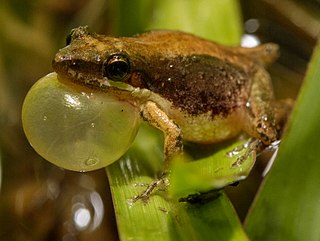
The wallum sedge frog, also known as the Olongburra frog or the sharp-snouted reed frog, is a species of frog that is endemic to Australia. Varying in color from brown to dark green it inhabits the thick and often acidic marshes of the Wallum along the coast of Queensland and New South Wales. Mating season comes in early spring, often after heavy rainfalls. Females attach their eggs to grasses and sedges. Their call is high pitched and follows a "creeeek... crik" pattern.

The hidden-ear frog is a species of frog in the family Hylidae. It is endemic to Australia. Its natural habitats are subtropical or tropical dry lowland grassland and intermittent freshwater marshes. It is green or dull brown coloured.

Hallowell's tree frog is a species of frog in the family Hylidae.
Hyla zhaopingensis is a species of frogs in the family Hylidae endemic to China. Its natural habitats are subtropical or tropical moist lowland forests, swamps, freshwater marshes, intermittent freshwater marshes, arable land, plantations, rural gardens, heavily degraded former forests, ponds, and irrigated land. It is threatened by habitat loss.

Horst's tree frog is a species of frog in the subfamily Pelodryadinae. It is found in New Guinea. Its natural habitats are subtropical or tropical moist lowland forests, subtropical or tropical swamps, swamps, freshwater marshes, intermittent freshwater marshes, rural gardens, and heavily degraded former forests.
"Litoria" castanea, also known as the yellow-spotted tree frog, New England swamp frog, tablelands bell frog, or yellow-spotted bell frog is a species of frog in the subfamily Pelodryadinae. It is a critically endangered species of frog that is endemic to south-eastern Australia.

Copland's rock frog or the saxicoline tree frog is a species of frog in the subfamily Pelodryadinae. It is endemic to Australia, in a range extending from the Kimberley region of Western Australia to Arnhem Land and a record in the north of Queensland. Its natural habitats are subtropical or tropical dry shrubland, subtropical or tropical dry lowland grassland, intermittent rivers, and rocky areas.
The buzzing tree frog is a species of frog in the subfamily Pelodryadinae. It is endemic to Australia. Its natural habitats are temperate forests, subtropical or tropical swamps, swamps, intermittent freshwater lakes, intermittent freshwater marshes, and urban areas.

Everett's tree frog or the Timor tree frog is a species of frog in the subfamily Pelodryadinae. The scientific name commemorates the British colonial administrator and zoological collector Alfred Hart Everett.
Litoria havina is a species of frog in the subfamily Pelodryadinae. It is found in New Guinea.

The bumpy rocket frog, also known as Peters' frog, is a species of frog in the subfamily Pelodryadinae. It is abundant and endemic to Australia, where it is found from northern Australia south to Maryborough, Queensland.
The long-snouted frog is a species of frog in the subfamily Pelodryadinae. It is endemic to Australia. The frog is also known as the long-nosed tree frog, scrub rocket frog, and sharp-snouted frog.

The javelin frog is a species of frog in the subfamily Pelodryadinae, that is endemic to Australia. Its natural habitats are subtropical or tropical dry lowland grassland, swamps, and intermittent freshwater marshes.

The bridled frog is a species of frog in the subfamily Pelodryadinae. It is found in Australia and New Guinea. Its natural habitats are subtropical or tropical dry forests, moist savanna, intermittent rivers, swamps, intermittent freshwater marshes, and ponds. It is threatened by habitat loss.
The masked frog or masked rock frog is a species of frog in the subfamily Pelodryadinae, endemic to Australia. Its natural habitats are subtropical or tropical dry forests, subtropical or tropical dry lowland grassland, rivers, freshwater marshes, and intermittent freshwater marshes.
Litoria pronimia is a species of frog in the subfamily Pelodryadinae. It is found in New Guinea. Its natural habitats are subtropical or tropical moist lowland forests, subtropical or tropical moist montane forests, swamps, freshwater marshes, intermittent freshwater marshes, and canals and ditches. It is threatened by habitat loss.
The Efogi tree frog is a species of frog in the subfamily Pelodryadinae. It is found in New Guinea.

The Treasury Island tree frog is a species of frog in the subfamily Pelodryadinae. It is found in New Guinea and the Solomon Islands. Its natural habitats are subtropical or tropical moist lowland forests, subtropical or tropical moist montane forests, swamps, freshwater marshes, intermittent freshwater marshes, rural gardens, heavily degraded former forests, and canals and ditches. It is threatened by habitat loss.

Tornier's frog is a species of frog in the subfamily Pelodryadinae. It is endemic to Australia.

Vaillant's frog is a species of frog in the family Ranidae found in Central America. Its natural habitats are subtropical or tropical dry forests, subtropical or tropical moist lowland forests, subtropical or tropical swamps, rivers, swamps, freshwater lakes, intermittent freshwater lakes, freshwater marshes, intermittent freshwater marshes, rural gardens, heavily degraded former forests, water storage areas, ponds, and canals and ditches.














